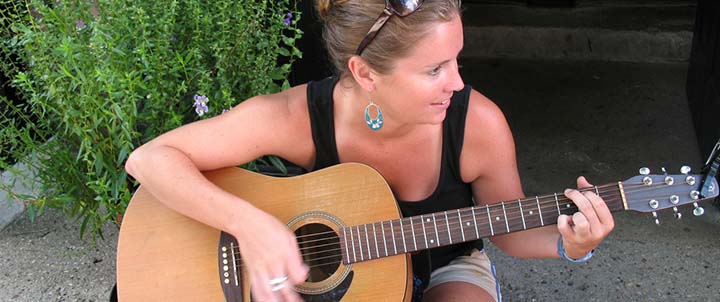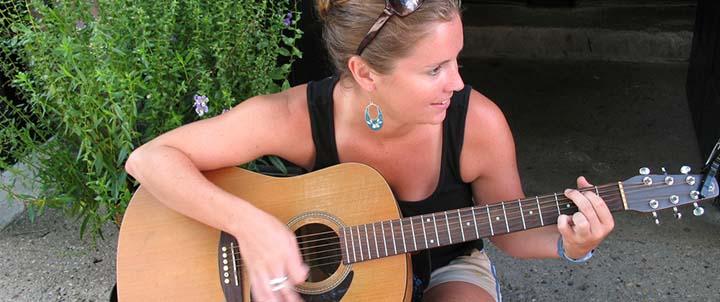 As a beginner, proper guitar posture is one of the most important beginning steps before you learn about chords, picking, and strumming. Sadly, learning proper guitar posture is often an afterthought to learning to play. Although whether you choose to sit or stand has little effect on your tone or technique, proper guitar posture is important for many other reasons.
As a beginner, proper guitar posture is one of the most important beginning steps before you learn about chords, picking, and strumming. Sadly, learning proper guitar posture is often an afterthought to learning to play. Although whether you choose to sit or stand has little effect on your tone or technique, proper guitar posture is important for many other reasons.
Why Is Proper Posture Important?
Proper guitar posture makes the work of your hands and fingers easier, conserving your energy. It also dramatically improves your skills as a guitarist, and prevents injuries from overuse.
Pitfalls of Poor Posture:
-
Poor instrument tone
-
Difficulties playing fast or advanced passages
-
Players may tire more quickly
-
Sprains and injuries, such as tendonitis, particularly in the wrist
Proper Guitar Posture: Modern Seated Position
-
Sit with your back straight and your feet slightly apart.
-
While sitting, rest the waist of your guitar – the indented part between the guitar’s upper and lower bouts or curved parts – on your right leg.
-
Rest the guitar lightly on your right forearm, on the base bout, balancing the guitar. Note: You should be able to able to take your left hand completely off the fretboard without the guitar dropping toward the floor.
-
Elevate your guitar using a support arm between your left thigh and the guitar’s lower side so that your left foot can remain on the floor.
Proper Guitar Posture: Classical Seated Position
For those on the path to pursuing a classical guitar career, it’s traditional to play in the seated position only, with the guitar resting on your left leg. This is because this position puts the guitar closest to the center of your body, in the optimum position for executing the difficult fingerings of classical guitar music. The steps for proper guitar posture for the classical guitarist are as follows:
-
Sit with your back straight and your feet slightly apart.
-
While sitting, rest the waist of your guitar – the indented part between the guitar’s upper and lower bouts or curved parts – on your left leg.
-
Rest the guitar lightly on your left forearm, on the base bout, balancing the guitar. Note: You should be able to able to take your right hand completely off the fretboard without the guitar dropping toward the floor.
-
Elevate your classical guitar by raising the left leg using a specially made guitar foot stool.
Don’t Neglect These Important Tips for Maintaining Proper Guitar Posture While in Seated Position:
-
Your legs may be crossed or uncrossed, but your knees should be high enough to support the guitar at or just below chest height.
Rest the dip of the guitar on your lap and the body of the guitar flat against your chest.
Don’t hunch your back.
Point your elbow toward the top corner of the guitar, resting it so that your forearm and wrist can pivot over the strings while supporting the guitar against your body.
Be aware of the angle of your fret hand. Don’t bend the arm of your fret hand beyond a 90-degree right angle. “Don’t be obtuse” – acute angles put less strain on your wrist.
Proper Guitar Posture: Standing
-
Add a guitar strap for support in standing position. Choose a new, quality strap over an old, worn strap to prevent dropping and damaging your guitar if the strap slips off a pin.
-
Adjust the length of the guitar strap and the height of the guitar until you can reach the fretboard and strings comfortably. You don’t want the guitar hanging too low as this will result in the need to bend your wrists at an awkward angle to play, making fast passages more difficult.
-
Your body should make the adjustment from sitting to standing naturally. However, keep the following tips in mind to ensure proper guitar posture when standing:
-
Keep your back straight, but relaxed.
-
Hold the elbow of your strumming arm forward and square with your body (toward the top corner of your guitar – not back behind you) to provide an optimum pivot point for strumming.
-
Be aware of the angle of your fret hand. Don’t bend the arm of your fret hand beyond a 90 degree right angle. “Don’t be obtuse” – acute angles put less strain on your wrist.
-
Bend your left leg slightly for support, so you don’t have to hunch over if you need a better view of the fretboard.
-
Selecting the right tools also helps ensure proper guitar posture:
-
Find your perfect chair. The ideal chair should have no arms. The height of the chair should be such that your feet rest flat on the floor and your lap is flat, not angled. If you are standing next to the chair, the seat of the chair should fall right in the middle of your knees.
-
Pay attention to your stand – your music stand, that is. Don’t place it too low or too high. Prevent the head tilting that leads to headaches, back, and neck strain by adjusting your music stand so that your don’t have to tilt your head to read music.
-
Find a great teacher. Opt for private, one-on-one lessons with a great teacher who is well-versed in the ins and outs of playing and proper guitar posture to avoid misinformation and to ensure you reach your fullest potential.
While imitating your favorite player may be fun, don’t make it a habit if that player’s posture is poor. Remember, proper guitar posture results in better guitar playing and a pain-free body – so save your Alice Cooper impressions for when you’re goofing off with your friends.
Photo by afunkydamsel
Megan L.

